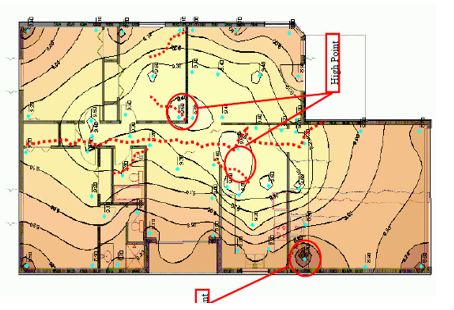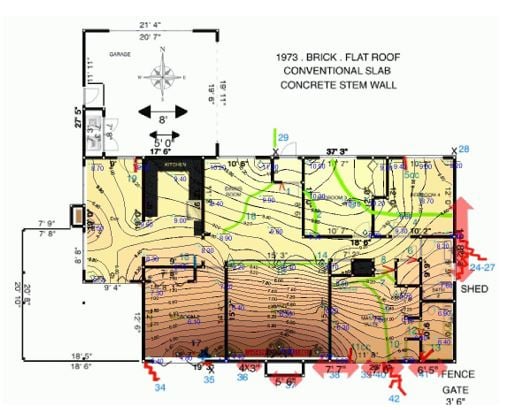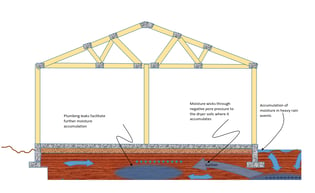In my last blog, we discussed basic patterns that can help identify foundation heave or settlement. I noted that since the elevations are only relative to each other, more data is needed in arriving at robust conclusions. I want to make one important rule. Never look at topo data without examining it together with signs of stress and other data.
In reexamining the topo of the last blog the diagonal crack in the floor and the cracks bordering the low area in the walls help point us to the conclusion of settlement in that area.
.jpg?width=447&name=Rot%20XI%201%20(1).jpg)
Now take a look at another elevation survey from the last blog:

In the above example, the crack running down the middle of the floor and the other interior damage and a lack of perimeter wall damage all point to a classic dome heave.
Sometimes, the topo patterns are not so obvious and require more thought and data to reach supportable conclusions. Take the example below. One side is high and the other side is low. Has the high side heaved? Or has the low side settled? Or both?
 At this point, the other tips raised in earlier blogs. In the above example, there is significant damage in the walls of the lower readings that indicate footing settlement.
At this point, the other tips raised in earlier blogs. In the above example, there is significant damage in the walls of the lower readings that indicate footing settlement.
Other things to consider:
- There are also floor cracks in the high area, which could indicate heave of the floor slab
- Are the baseboards crammed in the high areas?
- What are the local historical soil types? (clay or sands?)
- What is the historical climate condition? (wet or dry?)
- What side is exposed to the sun?
- Which way does the drainage flow around the house?
- Are there trees and or grass on portions of the home?
- What is the foundation type? How old is the home?
All of these, as discussed in the previous blogs, will come into play in helping reach supportable conclusions. Even after examining all of this data sometimes even more is needed. In my last blog of this series, I will discuss what to do in case the after all of this there is there are no solid conclusions.
Next: Rules of Thumb XII: https://www.foundationaz.com/blog/rules-of-thumb-diagnosing-foundation-problems-part-xii
Previous: Rules of Thumb X: https://www.foundationaz.com/blog/rules-of-thumb-for-diagnosing-foundation-problems-part-x






